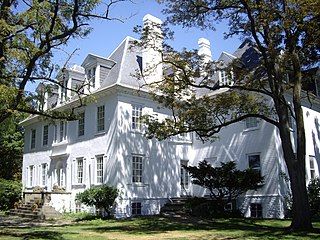
The Clermont State Historic Site, also known as the Clermont estate, the Clermont Manor or just Clermont, is a New York State Historic Site in southwestern Columbia County, New York, United States. It protects the former estate of the Livingston family, seven generations of whom lived on the site over more than two centuries.

Lyndhurst, also known as the Jay Gould estate, is a Gothic Revival country house that sits in its own 67-acre (27 ha) park beside the Hudson River in Tarrytown, New York, about a half mile south of the Tappan Zee Bridge on US 9. The house was designated a National Historic Landmark in 1966.

Sunnyside (1835) is an historic house on 10 acres along the Hudson River, in Tarrytown, New York. It was the home of the American author Washington Irving, best known for his short stories, such as "Rip Van Winkle" (1819) and "The Legend of Sleepy Hollow" (1820).

The Spencer–Peirce–Little Farm is a Colonial American farm located at 5 Little's Lane, Newbury, Massachusetts, United States, in the midst of 231 acres (93 ha) of open land bordering the Merrimack River and Plum Island Sound. The farmhouse, dating to c. 1690, was designated a National Historic Landmark in 1968 as an extremely rare 17th-century stone house in New England. It is now a nonprofit museum owned and operated by Historic New England and open to the public several days a week during the warmer months; an admission fee is charged for non Members.

Wilderstein is a 19th-century Queen-Anne-style country house on the Hudson River in Rhinebeck, Dutchess County, New York, United States. It is a not-for-profit house museum.

The Plumb-Bronson House, also known as the Dr. Oliver Bronson House and Stables, is a historic house on Worth Avenue in Hudson, New York. Built in 1811 and significantly altered in 1839 and 1849, it is an important early example of the Hudson River Bracketed style by Alexander Jackson Davis. The house was declared a National Historic Landmark in 2003.

The Hudson River Historic District, also known as Hudson River Heritage Historic District, is the largest Federally designated district on the mainland of the contiguous United States. It covers an area of 22,205 acres extending inland roughly a mile (1.6 km) from the east bank of the Hudson River between Staatsburg and Germantown in Dutchess and Columbia counties in the U.S. state of New York. This area includes the riverfront sections of the towns of Clermont, Red Hook, Rhinebeck and part of Hyde Park. This strip includes in their entirety the hamlets of Annandale, Barrytown, Rhinecliff and the village of Tivoli. Bard College and two protected areas, Margaret Lewis Norrie State Park and Tivoli Bays Unique Area, are also within the district.
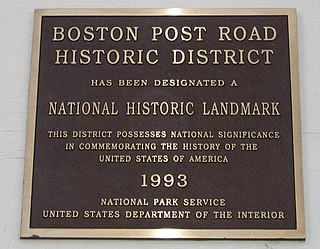
The Boston Post Road Historic District is a 286-acre (116 ha) National Historic Landmark District in Rye, New York, and is composed of five distinct and adjacent properties. Within this landmarked area are three architecturally significant, pre-Civil War mansions and their grounds; a 10,000-year-old Indigenous peoples site and viewshed; a private cemetery, and a nature preserve. It is one of only 11 National Historic Landmark Districts in New York State and the only National Historic Landmark District in Westchester County. It touches on the south side of the nation's oldest road, the Boston Post Road, which extends through Rye. A sandstone Westchester Turnpike marker "24", inspired by Benjamin Franklin's original mile marker system, is set into a wall that denotes the perimeter of three of the contributing properties. The district reaches to Milton Harbor of Long Island Sound. Two of the properties included in the National Park designation are anchored by Greek Revival buildings; the third property is dominated by a Gothic Revival structure that was designed by Alexander Jackson Davis.

Locust Grove is a National Historic Landmark estate located on US 9 in the Town of Poughkeepsie, New York. The 200-acre park-like estate includes homes, a carriage house, ice house, trails, a flower garden, and vegetable garden, and it overlooks the Hudson River from a bluff. The property includes a home designed by architect Alexander Jackson Davis for Samuel F. B. Morse, the inventor of the telegraph. An Italianate style mansion, it was completed in 1851.

Springside was the estate of Matthew Vassar in Poughkeepsie, New York, United States. It is located on Academy Street just off US 9. Detailed plans for a landscape, villa, and complex of farm buildings were drawn up by the influential Andrew Jackson Downing with assistance of Calvert Vaux prior to the former's death. The landscaping was completed and remains Downing's most intact surviving landscape, but only a few of the buildings he planned were ever built; most have since been lost to fire and structural failure. A cottage where Vassar resided was dismantled and removed in the mid-1970s. Its facade is on display in the New York State Museum.
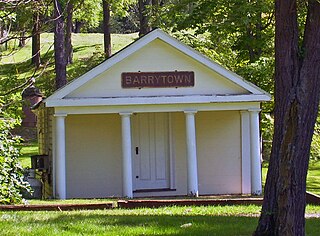
Barrytown is a hamlet within the town of Red Hook in Dutchess County, New York, United States. It is within the Hudson River Historic District, a National Historic Landmark, and contains four notable Hudson River Valley estates: Edgewater, Massena, Rokeby, and Sylvania.

Plumbush is the former house and farm of Robert Parker Parrott, inventor of the Parrott gun. It is located at the junction of NY 9D and Peekskill Road south of Cold Spring, New York, United States.

Castle Rock, also called Cat Rock or Osborn Castle, is the estate of former Illinois Central Railroad president William H. Osborn in Garrison, New York, United States. It sits on the hill of the same name, looking down on the Hudson River 620 feet (190 m) below. Visible from West Point across the river and traffic on NY 9D passing through Garrison, it has become one of the most recognizable man-made landmarks of the Hudson Highlands.

The Coons House is located along NY 9G in Clermont, New York, United States, across the road from the Clarkson Chapel. It was built in the mid-19th century in the Greek Revival architectural style.

Echo Lawn Estate, also known as Stonegate after the Great War, is a historic estate located at Balmville in Orange County, New York. The main house was built about 1860 and is a two-story brick dwelling in the Second Empire style. It features sweeping concave mansard-type roofs. Also on the property is a cluster of mid-19th-century service buildings, an early 20th-century formal garden, and a substantial set of Arts and Crafts inspired gateposts and stone walls.

Nut Grove, also known as the William Walsh House, is a historic house located on McCarty Avenue in Albany, New York, United States. It is a brick building originally designed in the Greek Revival architectural style by architect Alexander Jackson Davis in the mid-19th century. In 1974 it was listed on the National Register of Historic Places.

Rokeby, also known as La Bergerie, is a historic estate and federally recognized historic district located at Barrytown in Dutchess County, New York, United States. It includes seven contributing buildings and one contributing structure.
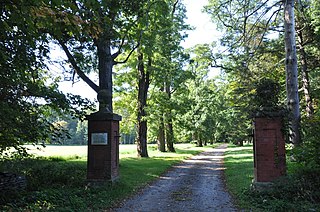
Grasmere is a national historic district and estate located at Rhinebeck, Dutchess County, New York. It was built by Janet Livingston Montgomery, widow of General Richard Montgomery.

True Farm is a historic farm and summer estate in Holderness, New Hampshire. Located off New Hampshire Route 113 on True Farm Road, the farm is based around a c.1820 farmhouse, and was expanded into a summer estate in 1920 by George Saltonstall West. The 100-acre (40 ha) estate includes numerous outbuildings and a lakefront cottage. The farm was listed on the National Register of Historic Places in 2012.
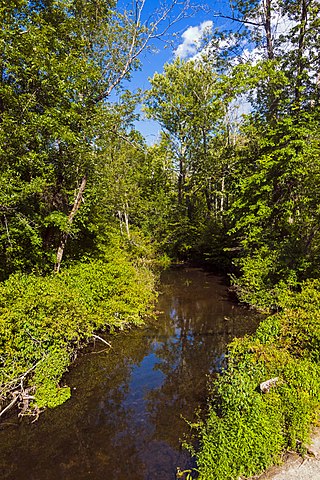
The Saw Kill is a 14.3-mile-long (23.0 km) tributary of the Hudson River, called the Metambesem by the Algonquin people of the area and sometimes called Sawkill Creek today. It rises in the town of Milan and drains a 22-square-mile (57 km2) area of northwestern Dutchess County, New York, that includes most of the town of Red Hook to the west and part of Rhinebeck to Red Hook's south.






























